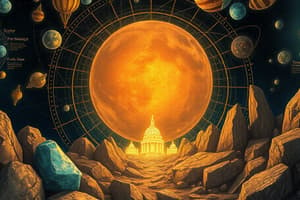Podcast
Questions and Answers
What is the primary energy source driving the water cycle?
What is the primary energy source driving the water cycle?
- Heat from the sun (correct)
- Geothermal energy from Earth's core
- Tidal energy from the moon
- Energy from Earth's rotation
What causes the tides?
What causes the tides?
- Gravitational pull of the moon and sun (correct)
- Changes in Earth's magnetic field
- Underwater volcanic activity
- Rotation of the Earth
Why is it difficult to make a scale model of the solar system?
Why is it difficult to make a scale model of the solar system?
- Differences in planetary rotation speeds
- Irregular shapes of planets
- The vast distances between planets (correct)
- Variations in planetary temperatures
What is the primary difference between weather and climate?
What is the primary difference between weather and climate?
What is the importance of the greenhouse effect?
What is the importance of the greenhouse effect?
What are greenhouse gases?
What are greenhouse gases?
What causes the tides?
What causes the tides?
What is the Foucault pendulum?
What is the Foucault pendulum?
Why it is difficult to make a scale model of the solar system?
Why it is difficult to make a scale model of the solar system?
What are greenhouse gases?
What are greenhouse gases?
What causes deep ocean currents and surface currents?
What causes deep ocean currents and surface currents?
What determines whether a statement describes weather or climate?
What determines whether a statement describes weather or climate?
What is the primary cause of the difference between spring tide and neap tide?
What is the primary cause of the difference between spring tide and neap tide?
Why is it difficult to make a scale model of the solar system?
Why is it difficult to make a scale model of the solar system?
What is the primary energy source driving the water cycle?
What is the primary energy source driving the water cycle?
How does the Coriolis Effect influence the movement of fluids on Earth?
How does the Coriolis Effect influence the movement of fluids on Earth?
What causes deep ocean currents?
What causes deep ocean currents?
Which statement describes climate?
Which statement describes climate?
What are greenhouse gases primarily responsible for?
What are greenhouse gases primarily responsible for?
What is the primary cause of the difference between spring tide and neap tide?
What is the primary cause of the difference between spring tide and neap tide?
What causes deep ocean currents and surface currents?
What causes deep ocean currents and surface currents?
What determines whether a statement describes weather or climate?
What determines whether a statement describes weather or climate?
What causes the tides?
What causes the tides?
What are greenhouse gases primarily responsible for?
What are greenhouse gases primarily responsible for?
How does the Coriolis Effect influence the movement of fluids on Earth?
How does the Coriolis Effect influence the movement of fluids on Earth?
What is the primary energy source driving the water cycle?
What is the primary energy source driving the water cycle?
What is the primary cause of the difference between spring tide and neap tide?
What is the primary cause of the difference between spring tide and neap tide?
What causes the waxing and waning phases of the moon?
What causes the waxing and waning phases of the moon?
Why is it difficult to make a scale model of the solar system?
Why is it difficult to make a scale model of the solar system?
What is the primary energy source driving the water cycle?
What is the primary energy source driving the water cycle?
Why do parts of the Earth receive direct sunlight or indirect sunlight during summer and winter seasons?
Why do parts of the Earth receive direct sunlight or indirect sunlight during summer and winter seasons?
How does the Coriolis Effect influence the movement of fluids on Earth?
How does the Coriolis Effect influence the movement of fluids on Earth?
Flashcards
Water Cycle's Driver
Water Cycle's Driver
The primary source of energy powering the evaporation, condensation, and precipitation processes in the water cycle.
Tides' Cause
Tides' Cause
The gravitational pull of the Moon and Sun on Earth's oceans, causing them to bulge and recede.
Solar System Scale Model Challenge
Solar System Scale Model Challenge
The immense distances between planets make it challenging to create an accurate and proportional scale model of the solar system due to the limitations of space.
Weather vs. Climate
Weather vs. Climate
Signup and view all the flashcards
Greenhouse Effect's Role
Greenhouse Effect's Role
Signup and view all the flashcards
Greenhouse Gases
Greenhouse Gases
Signup and view all the flashcards
Ocean Currents' Cause
Ocean Currents' Cause
Signup and view all the flashcards
Weather or Climate?
Weather or Climate?
Signup and view all the flashcards
Spring vs. Neap Tide
Spring vs. Neap Tide
Signup and view all the flashcards
Foucault Pendulum
Foucault Pendulum
Signup and view all the flashcards
Greenhouse Gas Function
Greenhouse Gas Function
Signup and view all the flashcards
Coriolis Effect's Influence
Coriolis Effect's Influence
Signup and view all the flashcards
Deep Ocean Currents' Cause
Deep Ocean Currents' Cause
Signup and view all the flashcards
Climate Definition
Climate Definition
Signup and view all the flashcards
Greenhouse Gases' Impact
Greenhouse Gases' Impact
Signup and view all the flashcards
Spring vs. Neap Tide Cause
Spring vs. Neap Tide Cause
Signup and view all the flashcards
Moon's Phases
Moon's Phases
Signup and view all the flashcards
Solar System Scale Model Challenge (2)
Solar System Scale Model Challenge (2)
Signup and view all the flashcards
Water Cycle's Driver (2)
Water Cycle's Driver (2)
Signup and view all the flashcards
Seasons' Sunlight Variation
Seasons' Sunlight Variation
Signup and view all the flashcards
Coriolis Effect's Influence (2)
Coriolis Effect's Influence (2)
Signup and view all the flashcards
Climate Definition (2)
Climate Definition (2)
Signup and view all the flashcards
Greenhouse Gases' Impact (2)
Greenhouse Gases' Impact (2)
Signup and view all the flashcards
Spring vs. Neap Tide Cause (2)
Spring vs. Neap Tide Cause (2)
Signup and view all the flashcards
Ocean Currents' Cause (2)
Ocean Currents' Cause (2)
Signup and view all the flashcards
Weather or Climate? (2)
Weather or Climate? (2)
Signup and view all the flashcards
Tides' Cause (2)
Tides' Cause (2)
Signup and view all the flashcards
Greenhouse Gases' Impact (3)
Greenhouse Gases' Impact (3)
Signup and view all the flashcards
Coriolis Effect's Influence (3)
Coriolis Effect's Influence (3)
Signup and view all the flashcards
Water Cycle's Driver (3)
Water Cycle's Driver (3)
Signup and view all the flashcards
Spring vs. Neap Tide Cause (3)
Spring vs. Neap Tide Cause (3)
Signup and view all the flashcards
Moon's Phases (2)
Moon's Phases (2)
Signup and view all the flashcards
Solar System Scale Model Challenge (3)
Solar System Scale Model Challenge (3)
Signup and view all the flashcards




